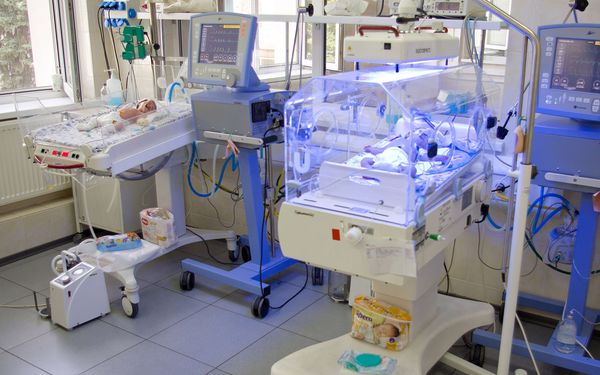
Two minibuses with gifts arrived at Kalinovka
The photo report for the sponsors
When we visited the children’s home at Kalinovka on 10 March 2007, we were stunned at the things we saw and firmly resolved to visit this place one more time. Since we did not wish to arrive at Kalinovka with empty hands, we therefore faced the task of finding sponsors willing to provide at least a month’s supply of Pampers [disposable diapers] for fifty severely disabled child-orphans. Information about our previous trip, “From Heart to Heart -- 2” was placed on several web sites and forums. Olga, an employee of the British Embassy, responded to our request. She succeeded in persuading colleagues at the embassy to help the children’s home, almost 700 km. distant from Kiev. Following an intense campaign for donations, Pampers were purchased in the amount of nearly 5,000 UAH, and an embassy minibus was assigned for the delivery of the gifts from Kiev. Moreover, visitors of the [web]forums uaua.info, likar.info, and mamke.info handed over gifts for the children to the Kiev volunteers Lyuba Pavlova and Regina. In an ongoing effort to familiarize ourselves with all the internats and children’s homes in Zaporozhye Oblast other than Kalinovka, we also decided to visit the internat in the city Molochansk.
The date of the trip--1 June 2007--coincided entirely by chance with the Day of Protection of Children. To our surprise no related activity at all was observed on this day at both distant children’s homes. Several people took part in the trip--three Zaporozhe volunteers (Albert, Nadia, and Volodya), two girl clowns (Marina and Vika), Kristina, a journalist of the newspaper MIG, the driver Viktor, and associates of the British Embassy, Olga Kochetkova, Sergei Ganyshevich, Grigorii Storizhko. Several persons planned until the last minute to take part in the trip, but something prevented them. But, on the other hand, both minibuses were filled with gifts for the kids.
Just after 10:00 in the morning, we were already in Kalinovka. In contrast [to an earlier trip], we now arrived in daytime and not at the dark time of day. But the white, two-story building housing the bed-ridden children evoked similar, scary emotions, perhaps because of the absence of trees round about, perhaps because of the black smoke stack, or the hospital assortment of flowers, or all of these factors together. We began to unload the presents during which time our journalist Kristina chatted with the director of the children’s home Nikolai Viktorovich Slavov. The result of that contact will be incorporated into reportage in the pages of the next issue of MIG.

: Nadia, Albert [Pavlov], Nikolai Viktorovich (director of the Kalinovka facility), three employees of the home

The refectory at Kalinovka. [Prior to the Russian revolution, this building was the ornate residence for Jakob and Katharina Schmidt Dick on the Mennonite estate Steinbach.]
Soon our clowns Marina and Vika begin a performance for the children. It isn’t easy for them. In the first place, they did not appear in a hall but outdoors (hearing was not very good). Second, the audience is not a simple one, and how to conduct oneself with such [disabled] children is quite perplexing. Some of the children listen attentively to the clowns and clap their hands, while others, completely [unable] to turn their attention to the performance, simply sit and rock from side to side. [This suggests autism. DPS] Remaining for about an hour in such surroundings, one understands how hard a time of it the caregivers have. And now, the performance having ended, we distribute gifts and take photographs for the report.


[Younger ambulant boys presenting with Down syndrome, cerebral palsy, and less apparent deficits are shown.]

[Young boys rummaging through gifts.]

[Interior shown of the little beds in one of the summer sleeping sheds.]

Older patients are busy with work on the farm, but [here] one of them wished to see the [clowns’] performance
Now we shift to the building for the bedridden children. [The building is the former estate dormitory or barn of the Jacob Dick compound at Steinbach. DPS] We must have brought from Kiev somewhere close to enough Pampers for one month [at the rate of] 150 Pampers for the children daily. We ascend [the stairs] to the second floor--and again it is not possible to control our emotions. Children lie, sit, or stand in their beds like in cages. One child lies completely motionless, but his little eyes dart as if counting the poles flying by out of the window of a train. Everything is clean and tidy, but the atmosphere is anything but homey. There are practically no toys on the beds. On the walls, except for rugs, there is nothing for the eye to rest on. I thought, what if they confined me in childhood to such a ward and never took me outside?--I would go mad and be no better off than these children. According to the aides, they seldom succeed in bringing the children outdoors, and some they never take out. The following reasons are given:
- The attendants and nurses just physically do not have time to carry the children outside; one attendant has to care for thirteen children.
- It is difficult for women to lift and carry out children from the second floor.
- Special wheelchairs or carriages are lacking.
- At the door in front of the building there is no shade for the bedridden, and in the hot period of the year the children immediately feel ill.
- For many of the children it makes no sense to carry them outdoors--after all they do not understand anything.


Exterior view of the building for bedridden children. The children are located in beds on the 2nd floor. [A small swing set is shown in the foreground, one of the only outdoor pieces of children’s equipment on the large campus.]


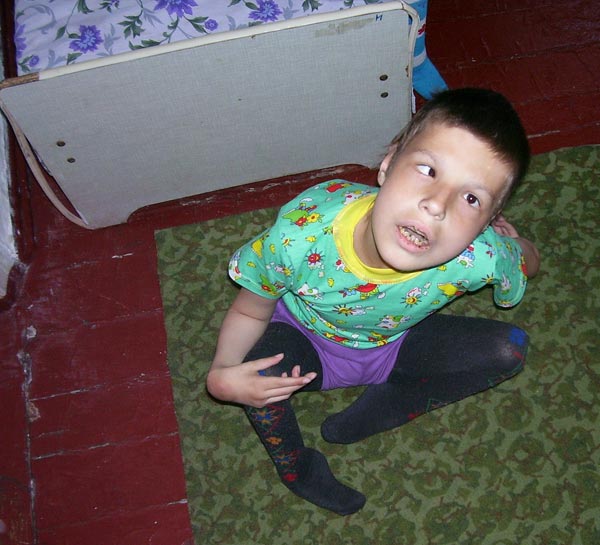

[Children lying or sitting on the beds are shown.]

Katya. [Young ambulant girls, ca. five years of age, sitting on small beds holding new dolls. Note: many of the girls at Kalinovka, perhaps most, have Down syndrome. DPS]
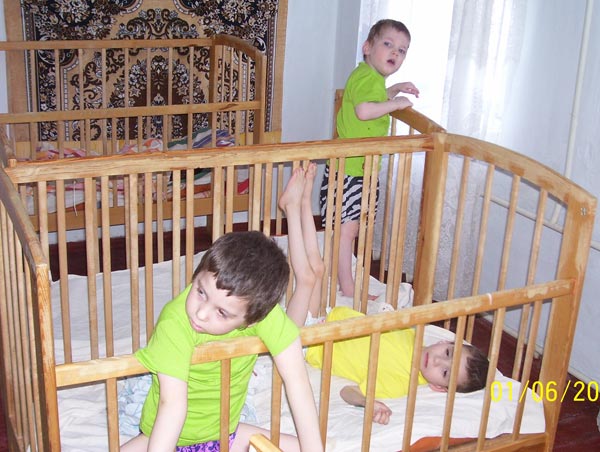

[Young boys, four-five, in beds, some lacking arms or leges or with Downs]
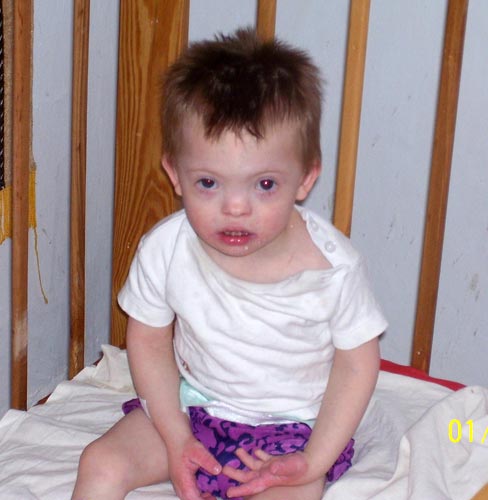

Gifts from sponsors: Pampers, music player, toys

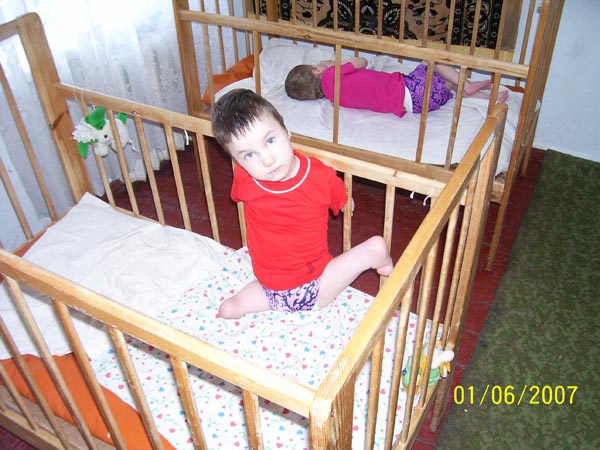

Alyosha with aide. [Note: Alyosha has no arms or legs. He is receiving a gift.]
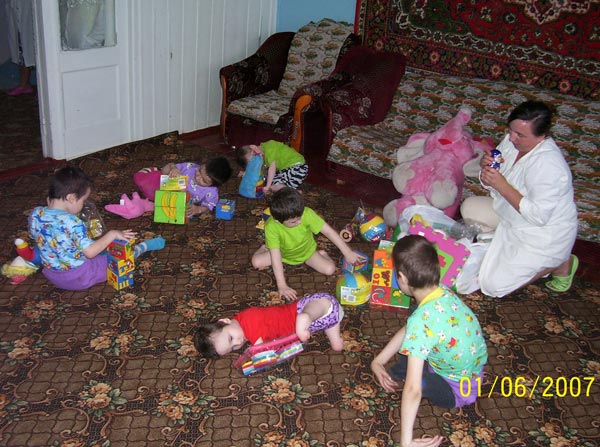
Children happy for new toys. [Note: six young boys lacking full arms or legs]
The extent of the damage to the nervous system and to the entire organism varies considerably with different children here. Several lie the entire day, virtually not moving; others, by contrast, are very active and, one can say, glad for the contact. Alyosha sticks in our mind, a boy appearing to be six to eight years old who has practically no arms or legs, but, on the other hand, is rather bright and clever, loves toys, tries to move around on the floor by crawling. Katya, as well, comes to mind, a girl already sixteen years of age. She even sang a song for us, “Wind Blew from the Sea.” According to the personnel, in the building for the bedridden only five to eight children die annually.
There exist no steps or measures for raising the qualifications of the Kalinovka personnel. Both the director and the employees of the children’s home told us that they would be glad to learn how similar institutions operate--in our country and abroad--and what it is possible to do to improve the lives of such children. Unfortunately, for the unpretentious nurses’ aides and attendants there is no alternative but to play the hand dealt them, since they do not have the option of becoming familiar with state-of-the-art or world-class experience with similar children. In my opinion, reading Ruben Gallego’s book White on Black would make it possible to take a look at the problem through the eyes of the child and correspondingly to relate [this perspective] to their work. [Originally in Russian, this book was published in English translation in 2006 by Harcourt and is available on Amazon.com]
I would like to sum up everything that we found out about life at the children’s home in Kalinovka. In our view these are the main issus of the institution:
- The bedridden children have a right to appropriate development and care. Children suffering from sores or rash from constant lack of disposable diapers or insufficient care from the shortage of personnel--that is a travesty in the modern world.
- A ward or room in which a child is confined to bed will be home for her/him for many months or years. Consequently, the room should look like a comfortable child’s room with an abundance of soft toys variously adapted for the development of the faculties of the child. At present the room appears as a room with white walls, a pair of rugs, and beds on which the children recline all the time as in a cage. There are practically no toys on the beds.
- It is essential for children who are not prevented for medical reasons [for aides] to carry them regularly outside for a walk, [take] them to various events, and so on. Frequently carriages or wheelchairs are lacking to take such children for a walk.
- The number of children assigned to one aide (thirteen children) is simply too large. For that reason it is simple for the aide never to take a child outside [or] to give a child more love, [or] to attend to the development of existing skills for the child.
- The level or standard of medical care for these children is not apparent to us, but considering that even children at home not infrequently suffer from doctors’ negligence or indifference and lack of medicine, one may appreciate what happens with severely ill, abandoned children. The annual death rate for bedridden children at Kalinovka exceeds 10%–a depressing fact in our opinion. Frequently, half-consciously, people form the opinion that once a child is confined to bed then death for him is a deliverance from suffering. In so doing they do not take into account the sufferings and preferences of the children [themselves].
- Psychological and professional support for the personnel of Kalinovka Children’s Home is wanting. We believe it essential that there be professional training for the people who work with these children.
- Lacking, too, is social control to ensure compliance with the rights of disabled children. It seems to us that nothing is known about volunteers who might regularly visit this children’s home. [Meaning: volunteers might check on compliance?]
- Nothing is being done to find families or children’s homes of a family type at least for several of the children.
- A large number of children with serious disabilities [collected in one place] causes depression among all the children. The placement of a small number of children (ten to fifteen, for example) in a family-type children’s home might solve many problems and allow the children to develop more normally.
Our recommendations to improve the situation are as follows:
1. In the first place, it is imperative to establish social inspection or monitoring for the operation of the children’s home. A team of volunteers regularly visiting that institution (perhaps one every two weeks) might more deeply penetrate to the heart of the problems, help the personnel with the work with the bedridden children, and monitor the use of the arriving humanitarian aid.
2. Strive to meet the goal of bringing the bedridden children outside several times a week, or to other parts of the children’s home, or possibly [be taken] on excursions--if not prevented by medical considerations. To realize that goal it is necessary to acquire special carriages for the children, to call for increase in the staff, or to bring in volunteers.
3. In full measure provide the bedridden children with disposable diapers and toys.
4. Make a section for bedridden children similar to a comfortable kindergarten and not like a hospital (plenty of toys for development, pictures, children’s music and films, games with children).
5. Aim for an increase in the staff of caregivers in order to devote the greatest possible love and attention to each child.
6. Conduct seminars and training for the personnel of the internat. Distribute informational materials to the personnel.
7. Establish an experimental family-type home for ten-fifteen such children, the form or type for bringing up [the children] approaching that of a [normal] family. According to the results of studies of such a family-type home, [we] come to the conclusion that family-type homes are better for children’s lives.
8. Provide high quality medical care for the children. Information about the essential needs for medications or operations for a certain child might come from volunteers regularly visiting the children’s home.
Completing the report on the internat at Kalinovka, I paraphrase the words of one of the great animal researchers that nonetheless apply beautifully to humans: “It is not important how well their intelligence or physical possibilities develop. What is important is to take into account that they might [also] be suffering.” The abandoned children at Kalinovka must not suffer. And we [must] do everything in our power, so that they do not suffer.
Anyone wishing to offer assistance to realize our plans, please call +38 066 513 34 35 or +38 0612 67 89 58 (Albert) or detizp@mail.ru. Both material and organization help are welcome for carrying out these projects.
The Chernigovska Children’s Internat (statistics)
Chernigovskii Raion, Village of Kalinovka [formerly the Mennonite estate Steinbach owned by Schmidt and Dick families] (45 km. south from the raion center Chernigovka)
153 children, including [some] with profound retardation, cerebral palsy, [Down syndrome], and other disabilities.
30 girls. 50 bedfast children. Ages 4-18 (sometimes to 35-40).
Phone: +380 6140 9 87 49
Director: Nikolai Viktorovich Slavov (Cell phone: +38 066 977050)
Molochansk orphanage.
After Kalinovka we visited the school-internat in the little town of Molochansk. This town is located not far from Tokmak and was known to us only for its mineral water. The internat is located in a rather unusual place, on a large hill on the outskirts of the town. [The location lies west of the Molochnaia River in the formerly German village of Prischib. Molochansk was formerly the Mennonite town of Halbstadt, located on the east side of the Molochnaia.] In the summer the grass on the slopes of the hill is entirely burned by the sun, and the shade around the buildings is rather meager.
At the internat live and learn some 180 children, of whom around one-third are girls. There even children of Kindergarten age from four to seven years. Several of the children have the diagnoses of ZPR (delay in mental development) and retardation, but after Kalinovka, the Molochansk wards seemed to us entirely normal children.
The director of the internat, Yurii Vladimirovich Gerasimov, kindly met us and right away fed us abundantly in the dining hall. Under the influence of the terrific heat, a filling lunch, and the [lingering] images of Kalinovka, we begin to get drowsy. And still it was necessary to socialize with the children, perform a concert, and distribute gifts. It was difficult for the clowns Marina and Vika, who would have to cheer up a crowd of about 100 children under these trying conditions.

The clowns Marina and Vika
On the whole, the performance came off normally, only at the end the children were overcome with excitement at the sight of so many gifts, and to make a photo documentary for our sponsors was quite difficult. The kids grabbed the first toy at hand and ran away.
Impressions of the Molochansk internat--typical for such institutions. Such a great number of children without parents is a cause of perplexity and shame for our country. So many good, beautiful children’s faces, and for all of them [there should be] a place in a home with a mother and dad, perhaps not with blood relatives but at least with foster parents. But an internat--that is no place for them. One boy expressed the desires of all, telling the clowns about his dream: “I dream that I would have a first-rate family, and not a family of the sort my brother and I found ourselves in at the internat!”
Please look at the faces of these children and reflect--perhaps a place may be found for some one of them in your home?




The director of Molochansk orphanage Yuriy Vladimirovich
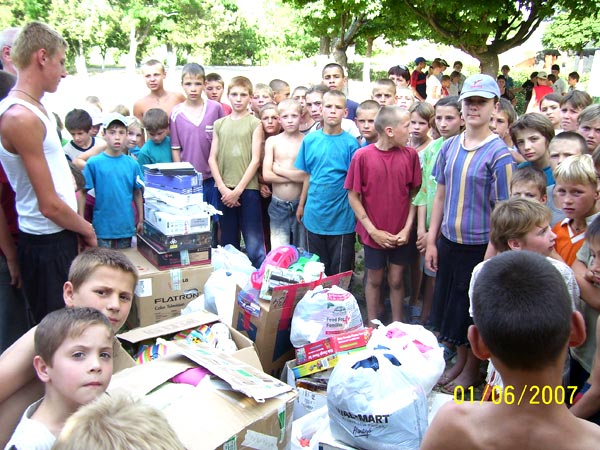
Molochansk Special General School-Internat for Orphans and Children Left without Parental Guardianship (information)
In the orphanage there are at about 180 children living and learning
Address: (in English)
71550, Zaporozhskaya oblast, Tokmatskiy rayon
g. Molochansk, ul. Osipenko 6
Director Gerasimov Yuriy Vladimirovich
Phone number: (380 6178) 4-04-13, 8 097 704 50 49
Photo report for the sponsors:
Many thanks to Olya and the staff of the British Embassy in Kiev, Amy S. from the USA, Kahpo from the USA, Marina from Italy, Valentina from Chernigovskaya oblast for the great quantity of presents that they sent to the kids.
We also thank Amy S., USA for $150 and Marino P., USA, for $150 transferred for the purchase of the TV, DVD player (that were presented to Molochansk) and a music centre (presented to Kalinovka). Many thanks to Volodya from Zaporozhye, that paid the minibus rent.
Kalinovka:
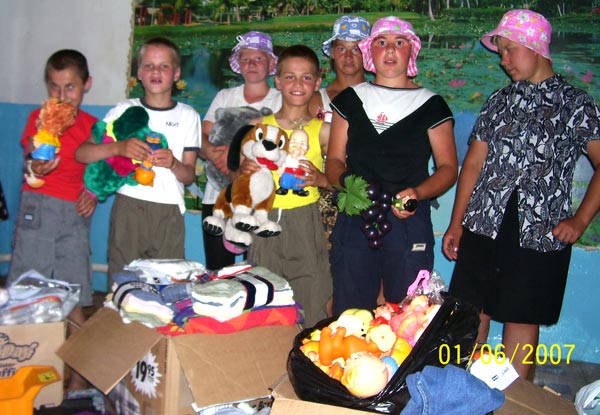










Molochansk:




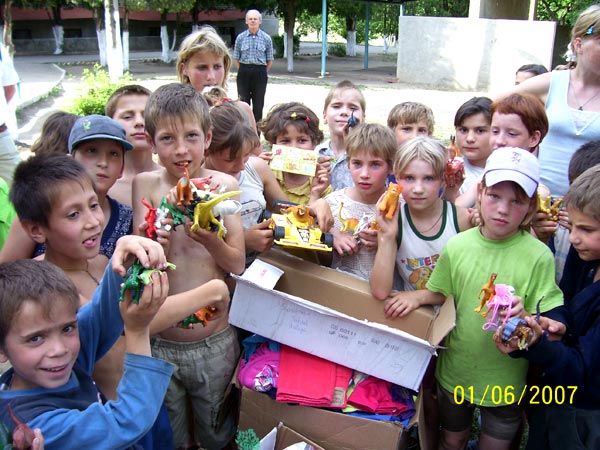

The director of Molochansk orphanage Yuriy Vladimirovich.



[Translated by David P. Sudermann, descendant of the original owners of Steinbach (Kalinovka), who lives with his family in Northfield, Minnesota, USA. dsudermann [at] charter.net]


